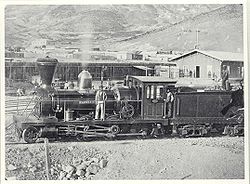Chañarcillo
| Chañarcillo | |
|---|---|
| Mining town | |

Chañarcillo train station in 1862
|
|
| Location in Chile | |
| Coordinates: 29°32′S 71°01′W / 29.533°S 71.017°WCoordinates: 29°32′S 71°01′W / 29.533°S 71.017°W | |
| Country |
|
| Region | Atacama Region |
| Province | Copiapó Province |
Chañarcillo is a town and mine in the Atacama Desert of Copiapó Province, Atacama Region, Chile, located near Vallenar and 75 kilometres from Copiapó. It is noted for its silver mining. The town grew up after the Chañarcillo silver mine was discovered on May 16, 1832 by Juan Godoy. This event sparkled the Chilean silver rush. It grew in prominence in the second half of the nineteenth century and became important in the Atacama mining industry and one of the most important mines to the Chilean economy. It was connected by railway before 1862. Today it is something of a ghost town, since mining activity has declined today.
Magnificent groups of large crystals have been found at Chañarcillo, including proustite, stephanite, chlorargyrite and adamite.
Chanarcillo is on the south flank of a dome, the Sierra de Chanarcillo, characterized by radial fractures and northwest striking faults. Silver ore occurs in nearly vertical veins within these fractures and faults within interbedded limestones and tuffs. This ore zone is an oxidized and supergene sulfide enriched rock. Oxidized ores occur above the water table and supergene sulfide enrichment below.
In the oxidized zone, ore minerals include native silver and argentite have been replaced by cerargyrite, iodobromite, bromyrite, embolite, iodyrite. In the supergene sulfide enriched zone, ore minerals include pearceite, proustite, tetrahedrite, polybasite, and pyrargyrite.
...
Wikipedia

